The laser is a powerful light source. It has extraordinary properties and is able to cover long distances with small variations. Based on the unique properties of the laser beam, laser cosmetology appeared. The direction is distinguished by penetrating hard-to-reach areas of the body, regulating the circulatory process, selecting the most appropriate method of exposure, adapting the parameters of the device to the characteristics of the patient's body. The ability to get beautiful skin without cuts and punctures attracts many people. Therefore, rejuvenation and other services involving high-energy beam manipulation are preferred to plastic surgeries and "beauty injections. "
Types of lasers

Different types of cosmetology lasers are used to achieve healing and corrective effects - it is advisable to ask the beautician immediately what kind of installation is used in the office. All types are united by the lack of scars, the consequences in the form of scars, which often occur after the interventions of aesthetic surgeons.
Existsthese types of lasers:
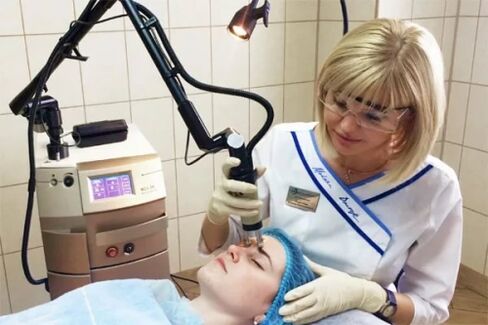
- Erbium. . . It penetrates shallowly, eliminating the error with maximum accuracy. The generated heat energy is quickly distributed so that nearby tissues are not damaged. Short, fast pulses must be balanced with the wavelength and energy density of the emitted wave. Only then are the side effects of the procedure ruled out. Erbium laser is used to qualitatively remove stretch marks, tighten and peel.
- Carbon dioxide. . . It has been used in cosmetology and medicine for nearly 40 years. Indications for repainting with this type of beams are age spots on the face and body, removal of tattoos, poor quality permanent makeup, removal of scars after surgeries, past injuries, attempts to eliminate acne on their own.
The carbon dioxide laser (the second name of the unit) is used to perform dermabrasion - a fairly serious cosmetic procedure. Improper handling of the device and rash setting of options will have irreversible consequences. The device allows the dosing of the high-energy beam, the control of the penetration depth and then its control. During a session, the beautician processes most of the skin. A direct indication of the use of a carbon dioxide laser is the need to remove the effects of papillomas, colloidal scars and acne. The patient will be able to normalize the condition of the skin if he has previously had a problem. The beautician eliminates dilated pores, smoothing the surface of the epidermis. The advantage of the procedure is the low number of relapses and side effects, the short recovery period. Disadvantages - redness lasts a long time in the treated area (up to 2 months). The phenomenon is accompanied by dilation of the capillaries - the small blood vessels are subjected to increased stress during the procedure. Improper dosing of the laser beam leads to scarring, weakening or, conversely, an increase in pigmentation.
- Ruby. . . This beam is used for epilation. Typical - the procedure can only be performed on light skin. By acting on tanned or naturally dark skin, it can cause pigment problems, causing burns under even more severe loads.
- Alexandrit. . . It creates a long-range radius that distinguishes it from its ruby counterpart. Processing requires constant external cooling of the tissues. It is used on a light skin surface provided there is no sunburn. Hair removal for a blond haired person is ineffective and even harmful.
- Diode. . . This type of laser is used for one of the most effective hair removal. The penetration depth of the beam shall not exceed 4 mm. The advantage of the method is that it does not violate the natural pigmentation of the body.

Also applyneodymium laser. . . The unique properties of the resulting energy flow allow it to be used for a variety of purposes - from removing poor quality permanent makeup to epilating. In addition to affecting the hair follicles and the skin’s natural pigment, the radiation also affects the small blood vessels. They are clotting. These types of equipment are only installed in special clinics, their presence in standard beauty salons is quite rare.
Indications for laser treatment
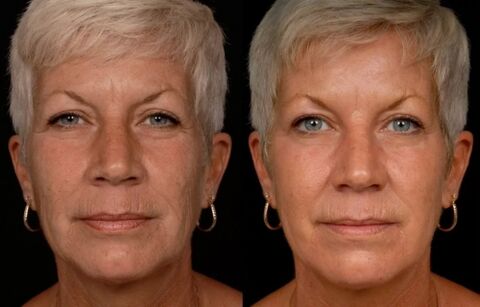

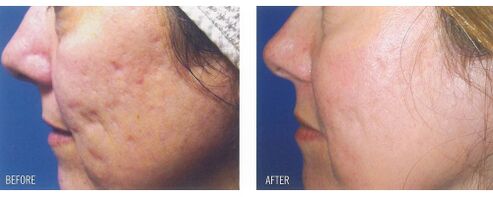
The prevalence of laser in cosmetology is explained by the versatile spectrum of direction. It will be helpful to contact a beautician and sign up for the procedure for those with such skin problems:
- Acne, after the effects of scars, blue spots.
- Wrinkles are typically mimicry, specifically age-related.
- Scars, regardless of their origin, expiration time.
- Sagging facial contours.
- Loose skin, decreased tone.
- Bags under the eyes.
- Hyperpigmentation on the face, body.
- Presence of dark circles under the eyes.
- Poor quality tattoos.
- Dilated pores.
After the treatment, the skin becomes velvety, smooth, soft and firm. The flaws disappear, giving the face and body an even texture. The duration of each procedure depends on the type of laser treatment, the patient's expectations, the amount of work to be done, and the degree to which the existing error is ignored. Sometimes the duration of a treatment is determined in advance by the age of the skin problem.
Selection of the beautician and contraindications to the procedure
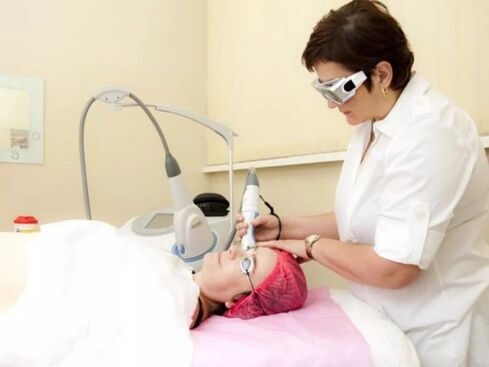
Laser correction has long been used in cosmetology. And since the introduction of the innovation, experts have identified almost all the features of the body in the presence of which it is better to refuse the procedure. The limitation is explained by the fact that exposure to high-energy radiation aggravates the course of pathological processes that are constantly present in the body.
The list of contraindications expands every month, as no rejuvenating, corrective effect is worth a person’s life - he is the priority. The fact that you have chosen the right beautician (and not a salon, medical center) is evidenced by your desire to gather as much information as possible about your health. The competent doctor always identifies all chronic diseases and also takes into account those in which the patient suffered from childhood. Find out all the medications you take regularly or intermittently. What matters is the tendency to develop an allergy, what lifestyle the patient is pursuing, whether they have had any experience with laser correction, what it has led to.
Absolutely all factors matter, and if a beautician simply appears indifferent to the procedure, he cannot be called competent.
If you have identified at least one contraindication, your doctor will suggest alternative ways to achieve the expected effect, or suggest that you completely abandon the idea of using a laser.
A competent physician will never perform such a procedure after becoming aware that the patient:
- Low blood clotting (haemophilia, including family history), tendency to thrombosis.
- Diseases of an autoimmune nature - rheumatoid arthritis, systemic lupus erythematosus.
- Inflammatory elements of unknown origin have been found on the skin of the face and body.
- Inflammatory processes and extensive skin lesions - psoriasis, dermatosis, herpes infection.
- Pre-cancerous condition.
- There are many moles on the body (more than 100).
- Natural sunburn (such as on the beach) leads to the formation of new moles. They are slightly darker than the already existing names or do not differ from their shades.
- Benign, malignant oncological tumors (localization does not matter).
- Diabetes, regardless of type.
- Hypertension.
- Chronic renal failure.
- Early postoperative period (weak immunity can cause an unpredictable skin reaction when rising to the surface).
- Severe ischemia.
- Flebeurism.
- Psychoemotional instability, presence of severe mental illness.
- The need to take sulfonamides, antibiotics, hormonal agents, fluoroquinolones, and drugs that increase the effects of ultraviolet radiation.
- It tends to activate colloidal scarring.
- Family history of vitiligo.
- Pregnancy, lactation.
The presence of these factors is incompatible with the use of the laser, and all these conditions are united by a common concept - absolute contraindications. If the beautician becomes aware of their presence, it is by no means possible to exert the effect with great energy. The procedure can speed up the course of oncological processes, take chronic diseases to an exacerbating stage, and turn moles into malignancies.

But there are a number of relative contraindications - most of them are temporary, and the beautician will only postpone the procedure until another date. These phenomena include:
- Acne, boils appear in the affected area.
- Increased body temperature.
- Respiratory infections.
- Fresh brown.
- Hypertensive crisis on the day of the planned manipulation.
- Menstruation.
- Chemical (acidic) peeling visit in the last 2 weeks. The skin needs to regenerate, otherwise the exposure will cause burns.
Laser treatment cannot be characterized as a harmless procedure. The ray penetrates the skin with the power of energy, destroying old cells, eliminating defective areas. If the body goes through features and pathologies and is prone to inappropriate reaction to ultraviolet light, the beautician should be warned.
Side effects of laser exposure
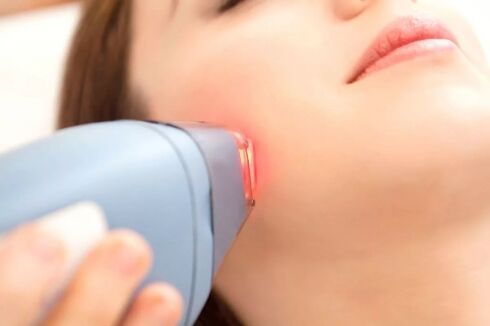
The laser beam is an invention designed to improve the appearance condition. The procedure is indeed effective and has already had an obvious positive effect on many people. But even these statistics may not provide possible negative outcomes in all further cases. The exact same treatment can be a real salvation for some patients against scars, acne and wrinkles, while for others it can cause body problems.
All negative outcomes have a cause - they are due to the beautician's illiteracy, the peculiarities of the patient's immunity, and the willingness to take care of the already treated skin surface. The laser beam can cause the following side effects:
- Burn (when the beautician made the wrong choice of exposure to the laser beam).
- Bark formation is normal in some types of laser procedures. But the appearance of the cortex, which causes pain even when imitating, is a pathology.
- Itching due to increased skin sensitivity.
- Redness - usually disappears after 2-3 days with systemic burns.
- Scarring of the tissue. The change in texture is the result of incorrect selection of processing parameters.
- Activation of herpes infection is the reaction of the body’s immune system to an irritant.
In addition, side effects include edema and the development of pus in the treated area. But this only happens in the case of a bacterial infection - when the patient rubs and combs the laser-polished surface.
If there are no obstacles to the procedure, laser treatment of the problem skin area will be the best solution to solve the problem. The vast majority of the medical literature describes the advantageous properties of a high-precision beam. Experiencing the mental discomfort resulting from the recognition of external inferiority, many have eliminated aesthetic imperfections and become happy thanks to the use of the laser.























